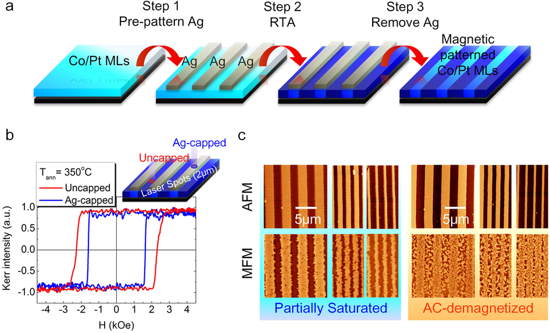Magnetic Patterning
Local manipulation of intergranular exchange coupling via grain boundary engineering
By Francis Pelletier | July 21, 2015 at 3:02 pmNature, Scientific Reports has published an article written by Kuo-Feng Huang, Jung-Wei Liao, Department of Materials Science and Engineering, National Tsing Hua University, Hsinchu, 300, Taiwan, Cheng-Yu Hsieh, Material and Chemical Research Laboratories, Nanotechnology Research Center, Industrial Technology Research Institute, Hsinchu, 310, Taiwan, Liang-Wei Wang, Yen-Chun Huang, Wei-Chih Wen, Department of Materials Science and Engineering, National Tsing Hua University, Hsinchu, 300, Taiwan, Mu-Tung Chang, Shen-Chuan Lo, Material and Chemical Research Laboratories, Nanotechnology Research Center, Industrial Technology Research Institute, Hsinchu, 310, Taiwan, Jun Yuan, Department of Physics, University of York, Heslington, York, YO10 5DD, United Kingdom, Hsiu-Hau Lin, Department of Physics, National Tsing Hua University, Hsinchu, 300, Taiwan, and Chih-Huang Lai, Department of Materials Science and Engineering, National Tsing Hua University, Hsinchu, 300, Taiwan.
(a) A flowchart of the proposed magnetic patterning process.
(b) Hysteresis loops of the magnetic patterned Co/Pt MLs acquired from
different regions by FMOKE.
(c) AFM (upper row) and corresponding MFM images (lower row)
of magnetic patterned Co/Pt MLs. The left (right) shows the partially
saturated (ac-demagnetized) state with different
width ratios of Ag-capped to uncapped stripes.
Abstract: “Magnetic patterning, with designed spatial profile of the desired magnetic properties, has been a rising challenge for developing magnetic devices at nanoscale. Most existing methods rely on locally modifying magnetic anisotropy energy or saturation magnetization, and thus post stringent constraints on the adaptability in diverse applications. We propose an alternative route for magnetic patterning: by manipulating the local intergranular exchange coupling to tune lateral magnetic properties. As demonstration, the grain boundary structure of Co/Pt multilayers is engineered by thermal treatment, where the stress state of the multilayers and thus the intergranular exchange coupling can be modified. With Ag passivation layers on top of the Co/Pt multilayers, we can hinder the stress relaxation and grain boundary modification. Combining the pre-patterned Ag passivation layer with thermal treatment, we can design spatial variations of the magnetic properties by tuning the intergranular exchange coupling, which diversifies the magnetic patterning process and extends its feasibility for varieties of new devices.“















 Subscribe to our free daily newsletter
Subscribe to our free daily newsletter


